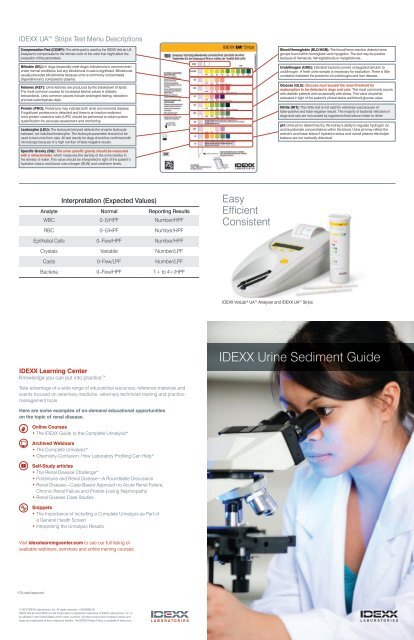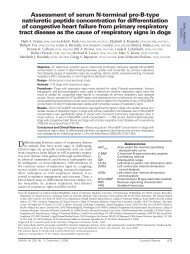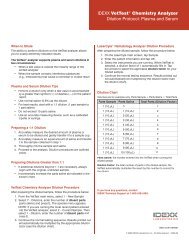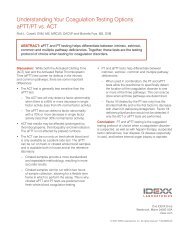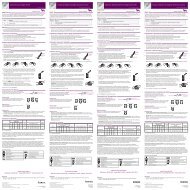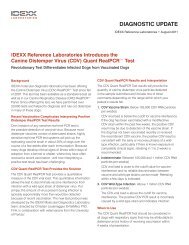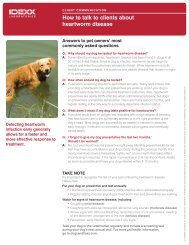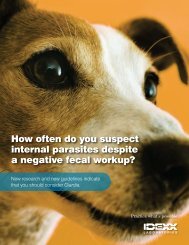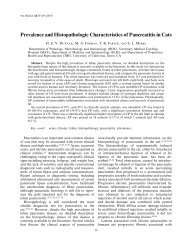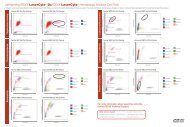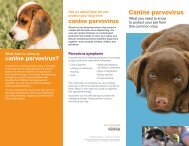Urine Sediment Guide - IDEXX Laboratories
Urine Sediment Guide - IDEXX Laboratories
Urine Sediment Guide - IDEXX Laboratories
- No tags were found...
You also want an ePaper? Increase the reach of your titles
YUMPU automatically turns print PDFs into web optimized ePapers that Google loves.
<strong>IDEXX</strong> UA Strips Test Menu DescriptionsCompensation Pad (COMP): This white pad is used by the <strong>IDEXX</strong> VetLab UAAnalyzer to compensate for the intrinsic color of the urine that might affect theevaluation of the parameters.Bilirubin (BIL): In dogs (especially male dogs), bilirubinuria is common evenunder normal conditions, but any bilirubinuria in cats is significant. Bilirubinuriausually precedes bilirubinemia because urine is commonly concentrated(hypersthenuric) compared to plasma.Ketones (KET): <strong>Urine</strong> ketones are produced by the breakdown of lipids.The most common causes for increased ketone values is diabeticketoacidosis. Less common causes include prolonged fasting, starvationand low-carbohydrate diets.Protein (PRO): Proteinuria may indicate both renal and nonrenal disease.If significant proteinuria is detected and there is an inactive sediment,urine protein:creatinine ratio (UPC) should be performed to obtain proteinquantification for accurate assessment and monitoring.Leukocytes (LEU): The leukocyte test pad detects the enzyme leukocyteesterase, not individual leukocytes. The leukocyte parameter should not beused to test urine from cats. All test results for dogs should be confirmed withmicroscopy because of a high number of false-negative results.Blood/Hemoglobin (BLD/HGB): The blood/heme reaction detects hemegroups found within hemoglobin and myoglobin. The test may be positivebecause of hematuria, hemoglobinuria or myoglobinuria.Urobilinogen (UBG): Intestinal bacteria convert conjugated bilirubin tourobilinogen. A fresh urine sample is necessary for evaluation. There is littlecorrelation between the presence of urobilinogen and liver disease.Glucose (GLU): Glucose must exceed the renal threshold forreabsorption to be detected in dogs and cats. This most commonly occurswith diabetic patients and occasionally with stress. This value should beevaluated in light of the patient’s clinical status and blood glucose value.Nitrite (NIT): The nitrite test is not valid for veterinary use because offalse-positive and false-negative results. The majority of bacterial infections indogs and cats are not caused by organisms that reduce nitrate to nitrite.pH: <strong>Urine</strong> pH is determined by the kidney’s ability to regulate hydrogen ionand bicarbonate concentrations within the blood. <strong>Urine</strong> pH may reflect theanimal’s acid-base status if hydration status and overall plasma electrolytebalance are not markedly disturbed.Specific Gravity (SG): The urine specific gravity should be measuredwith a refractometer, which measures the density of the urine relative tothe density of water. This value should be interpreted in light of the patient’shydration status and blood urea nitrogen (BUN) and creatinine levels.Interpretation (Expected Values)Analyte Normal Reporting ResultsWBC 0–5/HPF Number/HPFRBC 0–5/HPF Number/HPFEasyEfficientConsistentEpithelial Cells 0–Few/HPF Number/HPFCrystals Variable Number/LPFCasts 0–Few/LPF Number/LPFBacteria 0–Few/HPF 1+ to 4+/HPF<strong>IDEXX</strong> VetLab ® UA Analyzer and <strong>IDEXX</strong> UA Strips<strong>IDEXX</strong> Learning CenterKnowledge you can put into practice<strong>IDEXX</strong> <strong>Urine</strong> <strong>Sediment</strong> <strong>Guide</strong>Take advantage of a wide range of educational resources, reference materials andevents focused on veterinary medicine, veterinary technician training and practicemanagementtools.Here are some examples of on-demand educational opportunitieson the topic of renal disease.Online Courses• The <strong>IDEXX</strong> <strong>Guide</strong> to the Complete Urinalysis*Archived Webinars• The Complete Urinalysis*• Chemistry Confusion: How Laboratory Profiling Can Help*Self-Study articles• The Renal Disease Challenge*• Proteinuria and Renal Disease—A Roundtable Discussion• Renal Disease—Case-Based Approach to Acute Renal Failure,Chronic Renal Failure and Protein-Losing Nephropathy• Renal Disease Case StudiesSnippets• The Importance of Including a Complete Urinalysis as Part ofa General Health Screen• Interpreting the Urinalysis ResultsVisit idexxlearningcenter.com to see our full listing ofavailable webinars, seminars and online training courses.*CE credit approved.© 2012 <strong>IDEXX</strong> <strong>Laboratories</strong>, Inc. All rights reserved. • 09-65893-02<strong>IDEXX</strong> VetLab and <strong>IDEXX</strong> UA are trademarks or registered trademarks of <strong>IDEXX</strong> <strong>Laboratories</strong>, Inc. orits affiliates in the United States and/or other countries. All other product and company names andlogos are trademarks of their respective holders. The <strong>IDEXX</strong> Privacy Policy is available at idexx.com.
<strong>Urine</strong> <strong>Sediment</strong> <strong>Guide</strong>CellsFigure 1 Erythrocytes and one squamousepithelial cellFigure 2 Erythrocytes and two leukocytes(black arrows)Figure 3 Numerous leukocytes and fewrod-shaped bacteriaFigure 4 Many rod-shaped bacteria,100x objective field of viewFigure 5 Many leukocytes and large rodshapedbacteria (black arrowheads)Figure 6 Numerous bacteria and leukocytesFigure 7 Transitional epithelial cells Figure 8 Squamous epithelial cells Figure 9 Epithelial cells (black arrows), RBC(red arrows) and WBC (blue arrows)Figure 10 Transitional cell carcinoma(NMB wet prep on right)Figure 11 Transitional cell carcinoma(NMB wet prep on right)Figure 12 Transitional cell carcinoma,air-dried and Diff-Quik stainedCastsFigure 13 Hyaline cast (borders outlined)Figure 14 Left: Granular castRight: Mixed waxy and granular castFigure 15 Waxy castCrystals andMiscellaneousFigure 16 StruviteFigure 17 Amorphous (NMB wet prepon right)Figure 18 BilirubinFigure 19 Ammonium urateFigure 20 Left: Calcium oxalate monohydrateRight: Calcium oxalate dihydrateFigure 21 Drug (Tribrissen) crystals,10x objective field of viewAll images, unless otherwise indicated,are representative of a high power field ofview (40x objective field of view)Images and information provided by:Dennis B. DeNicola, DVM, PhD, DACVPRick L. Cowell, DVM, MS, MRCVS, DACVPMichelle Frye, MS, DVMFigure 22 Left: Fat droplets (red arrows, RBC)Right: SpermFigure 23 Pearsonema plicaFigure 24 Contaminant fragmented fiber


